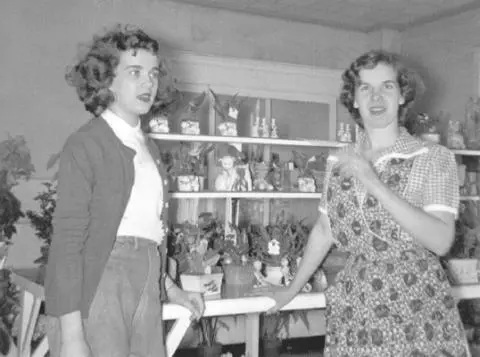Sally’s captivity lasted twenty-one months, from June 1948 to March 1950. At the twenty-first month mark of their connection, Lolita and Humbert land at Beardsley, where Humbert realizes that he no longer has the same hold on the girl he once possessed. He worries Dolores has confided the true nature of her relationship with her “stepfather” to her school friend, Mona. And that in doing so, she might be cherishing “the stealthy thought… that perhaps after all Mona was right, and she, orphan Lo, could expose [Humbert] without getting penalized herself.”
Dolores’s potential confession to Mona echoes Sally’s actual confession of her abuse at Frank La Salle’s hands, first to the unnamed school friend, and later to Ruth Janisch. And just as Sally’s escape comes about because of her long-distance phone call to her family, so, too, does Dolores make a mysterious phone call—immediately after fighting with Humbert— and then announces, “A great decision has been made.” She doesn’t flee him for another month, but the setup is already in place.
Then there is Humbert’s aside in Lolita ’s final chapter. He states that he would have given himself “at least thirty-five years for rape, and dismissed the rest of the charges.” The exact sentence Frank La Salle received.
Nineteen
Rebuilding a Life
Sally Horner was only two months past her eleventh birthday when Frank La Salle spirited her away from Camden. She returned home less than two weeks before turning thirteen on April 18. “When she went away she was a little girl,” Ella murmured on the day she was finally reunited with her daughter. “Now she is practically a young lady.” Sally had seen the country and how different so many other places were from Camden. She had been forced to grow up in the cruelest way possible, knowledge foisted upon her that could not be suppressed.
How the family marked her birthday isn’t known, since no one, aside from Sally’s niece, Diana, is alive to recall—and Diana was only twenty months old at the time. But a family outing to the Philadelphia Zoo, captured on a minute-long film clip shot by Sally’s brother-in-law, Al Panaro, appears to provide a possible answer. It is the only known surviving footage of Sally.
In it, Sally seems dressed for spring, wearing the same outfit that she had on the plane from California, as well as to court the day that Frank La Salle pleaded guilty to her kidnapping. Her sister, Susan, has on a cream or white coat covering a pale blouse and dark skirt, while Diana is dressed in a pink two-piece suit.
Sally walks, shoulders hunched, beside Susan. At one point she pushes her niece in a white-handled stroller. She moves slowly, with hesitation, but it’s not clear whether that’s how she really moved or if the film clip was preserved at a slower speed.
In a close-up, Sally’s face is angled to the left. Her expression is tentative, suggesting she still feels vulnerable out in public. That even though she is among her family, among those she loves, she isn’t ready to let down her guard.
She does not look at the camera once.
THERE WERE OTHER PRESSING MATTERS as Sally Horner readjusted to life with her family, in Camden and elsewhere. She had been taken at the tail end of sixth grade; in the fall she would start eighth grade at Clara S. Burrough Junior High School, and was eager for what promised to be a fresh start. When she had gone to school during her captivity period, her energy was focused on surviving each day with Frank La Salle instead of dreaming about what she might want to be when she grew up. Now that Sally was free, she could think of what she wanted, for her own future. “She has a definite ambition,” the San Jose detention center matron had said a few days after Sally’s dramatic rescue. “She wants to be a doctor.”
Ella, who had been out of work, needed to find a new job to support not only herself, but also a daughter who, through no fault of her own, was far closer to womanhood than any thirteen-year-old was supposed to be. Ella’s repetition to the press of the phrase “whatever Sally has done, I can forgive her” points to her discomfort about the abuse Sally suffered, or even her lack of comprehension.
There was no vocabulary, in 1950, to describe the mechanism or the impact of Sally’s victimization, where the violence was psychological manipulation, not necessarily brute force. Where the innocent-seeming facade of the father-daughter dynamic masked repeated rapes, unbeknownst to almost everyone around her. For Ella, who was struggling to pay the bills, put food on the table, and keep the lights on in the house, the details of Sally’s captivity may have been too much to bear. As was the idea of starting over where no one knew what had happened to her. The stigma they knew must have seemed a better choice than the uncertainty of what they didn’t know.
Taking Cohen’s advice under consideration, Ella opted for a compromise: Sally would spend the summer of 1950 with the Panaros in Florence, while Ella remained in Camden. No one changed their names, and no one would discuss what happened to Sally for decades.
Over the summer of 1950, Sally Horner allowed herself to feel safe. She looked after Diana when Susan and Al Panaro had to work in the greenhouse, and sometimes Sally tended to the flowers and herbs as well. One family photo shows Sally in the greenhouse next to Susan, wearing dungarees, a white shirt, and a dark cardigan, her curly hair tousled around her face and chin, her mouth open as she is caught in mid-conversation with her sister.

Sally Horner and her older sister, Susan Panaro, in the family greenhouse.
Other photographs from the same time suggest that living at the Panaros did Sally some good. One shows Sally standing by herself, clad in an elaborate pale-hued frock suitable for going to church or an afternoon social event. She’s smiling at the camera, though her eyes carry remnants of the shyness she displayed while being filmed at the Philadelphia Zoo.
Sally’s smile is wider in a second photo of her in a different fancy dress. Here she poses with a dark-haired young man wearing a suit at least two sizes too large. The boy is her apparent date, for a school dance or a church social. His name, and how the evening went, is lost to time—as is whether he was aware of what had happened to Sally.
By Sally’s fourteenth birthday in April 1951, she looked like the typical American teenager of that period, the type to be wowed by Perry Como or Tony Bennett or Doris Day or other popular singers of the time. (In Lolita, Nabokov dutifully listed the soundtrack of Dolores and Humbert’s road trip, including Eddie Fisher’s “Wish You Were Here,” Peggy Lee’s “Forgive Me,” and Tony Bennett’s “Sleepless” and “Here in My Heart.”)
One candid photo, likely taken by Al Panaro, hints at more complicated undercurrents in her than in a “bobby-soxer,” as Sally was sometimes referred to in the press coverage of her rescue. She wears jeans again, as she did in the greenhouse photo with Susan, but now her shirt is dark, and her curly hair is pulled back. Her lipstick looks near-black in the black-and-white photo, which suggests she is wearing a ruby-red shade. The camera has captured Sally as she emerged from her bedroom, newspaper in her right hand, expression quizzical, as if she’d been interrupted while reading the funnies. She seems to be in need of sleep, caffeine, or a combination of the two.

A candid shot of Sally holding a newspaper.
Though Sally adopted a mask of good-natured resilience, Al recalled his sister-in-law drifting into melancholic moods. She would be in the moment, then gone. A light would shine, and then flicker out. “She never said she was sad and depressed,” Al told me in 2014, “but you knew something was wrong.” The family discouraged discussion about her ordeal, and she almost never spoke of what happened with anyone. There were no heart-to-hearts. She underwent no psychological examinations; nor did she see a therapist. There was only Before, and After.
Читать дальше














